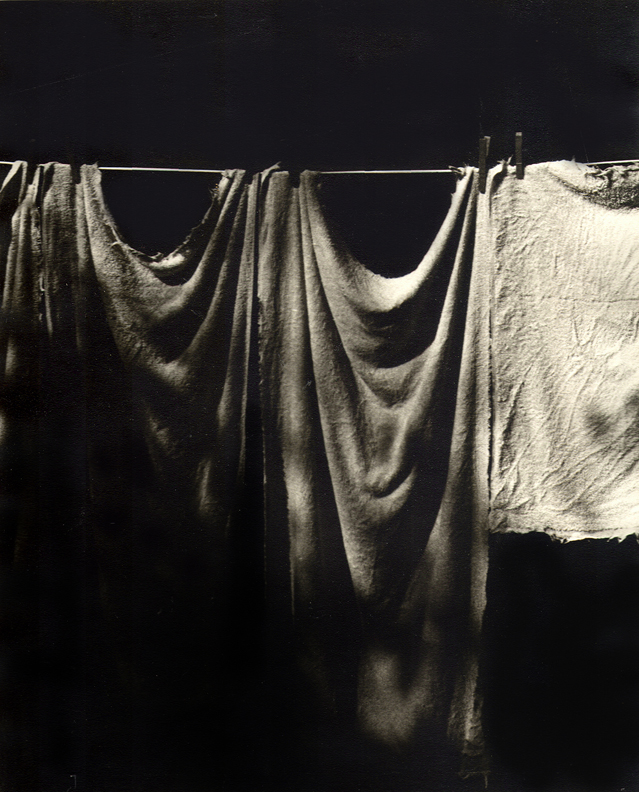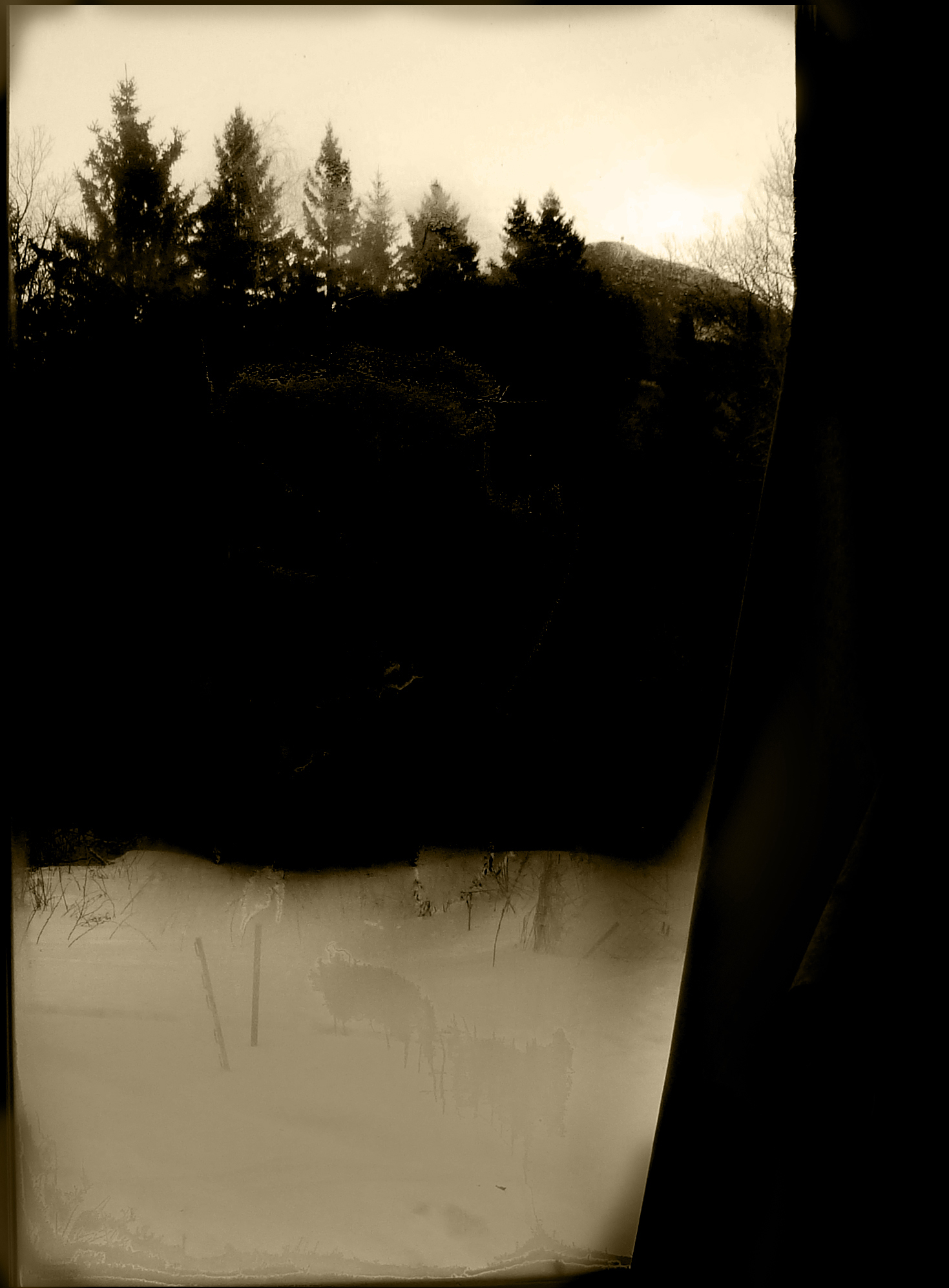09 Mar 2016 Joan Rachaelsdaughter: Slow Forward
On “Slow Forward,” a Retrospective of the Work of Joan Rachaelsdaughter at UMF Art Gallery, 10 March to 10 April 2016
Joan Rachaelsdaughter’s work combines, in uncanny distillations, intimately tactile materiality and formally realized visual image. Her best work is placed as if mystically in that fold where the material—the object that can be touched—becomes the visible, the form seen. Touch, the haptic, is always an atomized experience: one touches with one’s hands small areas of objects and cannot touch — simultaneously and all at once— an object larger than one’s body. Touch is specific to the delineations of one’s own inhabited body. Sight can, however, be expansive and encodes a path out of the limits of the self: illumination, enlightenment, these terms imply vision, light. Rachaelsdaughter’s work moves between touch and sight, creating palimpsestic photo- graphic images that evoke the realm of what is lost— coffee filters, old clothes, dis- carded books—and revivify the lost object as found vision. Metamorphosis is the trope and style of her work, and liminality her homeland.

Images of windows, books, clothes, moths, birds, angels, objects in the physical world that invoke transformation, departure, and liminality, make up much of her oeuvre. There is always an outside to Rachaelsdaughter’s work, or rather, a sense of emerging into an expansive unknown. Hers is an oeuvre of hinge— her images act as hinges thatopen from clothes, textiles, nature, politics, discarded household items, the human face, and from this opening move into a space that is unclaimed and unclaimable; in its refusal to claim, to settle, her delicate and forceful work is its most evocative. This farther space that I find in Rachaelsdaughter’s images puts me in mind of the late night fields and sky I used to watch, as a child, in my father’s car in the deep South— after we had been driving all day and well into the night, the hinge of exhaustion and placelessness would suddenly open to an expansive, terrifying, and beautiful contact with the very and actual distance of the land, its near endlessness, at the edge of human touch. Rachaelsdaughter’s life work, I think, has been to keep opening the sight of the edge of a journey, never closing down the vista.
Ten years ago, I wrote a small series of moth poems based on Rachaeldaughter’s “Moths” series of images. Her “Moths” originated as used coffee filters and, photographed with evocative dark blur, became the flickering umber presences that evoke the mythology of the moth as the soul that rises from the newly dead. I wrote not about moths as such but about Joan’s moths, their double-presence as the thing that is gone (the discarded coffee filter) and the thing that is saved (the gorgeous and haunting image of the ‘moth’). Rachaelsdaughter’s touch is so delicate, so deft, none of her works overbear. Instead, they retain their mystery: the Kinglet series, while it plays with the idea of mapping, also resists any direct mapping of bird and book and land.
The kinglet, the book, the land, all stand as openings through which a sacrificial time moves in Rachaelsdaughter’s kinglet series. The sacrificial is always present, just under the skin of Rachaelsdaughter’s images. If her earlier work emphasized textile, the delicate hanging garments conjuring meditations on the meaning of embodiment, her more recent work exposes the materiality of the gaze itself. “Full fathom five” offers an astonishing self portrait of the artist, seen as in a webbed but intact mirror, reminiscent of the obsidian mirrors used in the Americas before contact. The artist’s window, that I interpret always as a window watching Maine, presents a mythic Maine—not the tourist attraction of blueberries, blue sea, and blue skies, but the tractive and brooding Maine of winter and distance that cannot be owned, only limned by the longing eye. In Rachaelsdaughter’s work, the goal of longing is to watch: her work is very still and does not imply resolution to the visual webs it investigates. Instead, Rachaelsdaughter’s work stays in the realm of the watch- er, the gaze does not claim or take over what it sees but allows the act of seeing to be- come an invitation to the material world, beckoning the material world—birds, trees, the human face—to become manifest at the hinge of vision. Her invocation of religious symbols—the cross in “Tree Sacrifice” and the ankh in textile works—invites the viewer to contemplate the force and history of religion, making of given religious forms fresh, mysterious, and compelling myths. The work is not anti-religious nor conventionally religious but instead gets its charge from the feeling of being outside and look- ing in on something powerful and unknown.

Indeed, one of my favorite of Joan’s new images is a deceptively simple photograph of the view from her window. Tracing its lineage back to the beginnings of photography—Niepce’s “View from the Window at Le Gras” and Talbot’s “Oriel Window”—Rachaelsdaughter’s window view gazes toward a distinctly Maine skyline of evergreen trees, pointed firs, looming from a curved hill. This hill in the mystical darkness at the fold of her photograph looks as if it were part water part earth part sky, a dark fold matched by the edge of the image which is strongly framed by the presence of the wall/window frame, a dark line that is both grounding—it is from here that we gaze—and disturbing, the forceful absoluteness of the window frame’s heft contrasts with the dendritic fine hairs of the winter-stripped deciduous tree at the image’s edge. In the lower third of the image the glass of the window and ice and frost combine to give the impression that the whole scene is fragile, balanced on the vitreous breakable stuff of vision. And yet Rachaelsdaughter’s vision holds fast, through these decades of remarkable works, leading her audience through astonishing and subtle encounters with the self, the other, and the forms of the animal, plant, mystical worlds. The encounter is always with the visible, but the hither side of the visible. This retrospective at University of Maine Farmington is long overdue.
